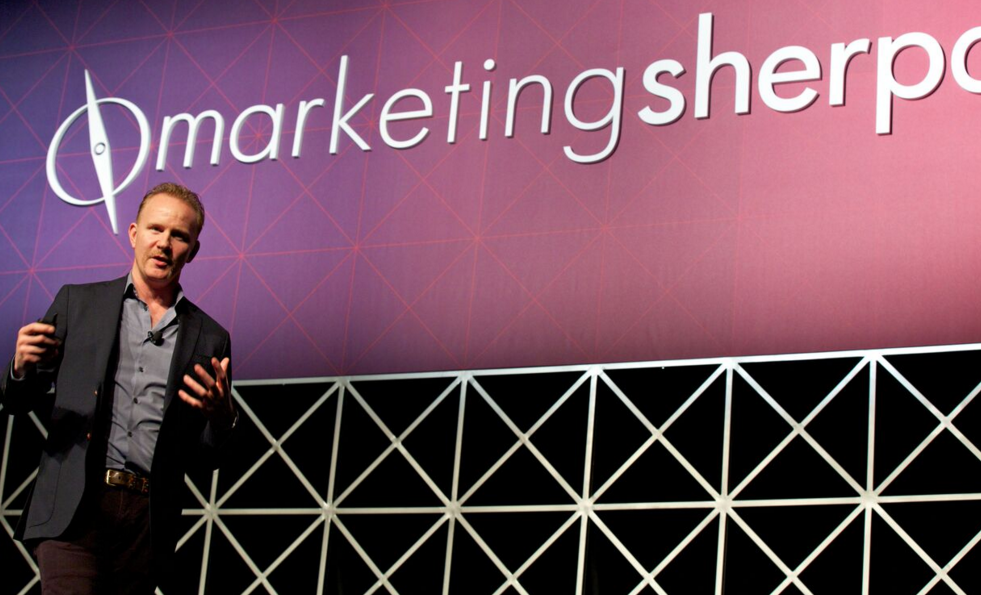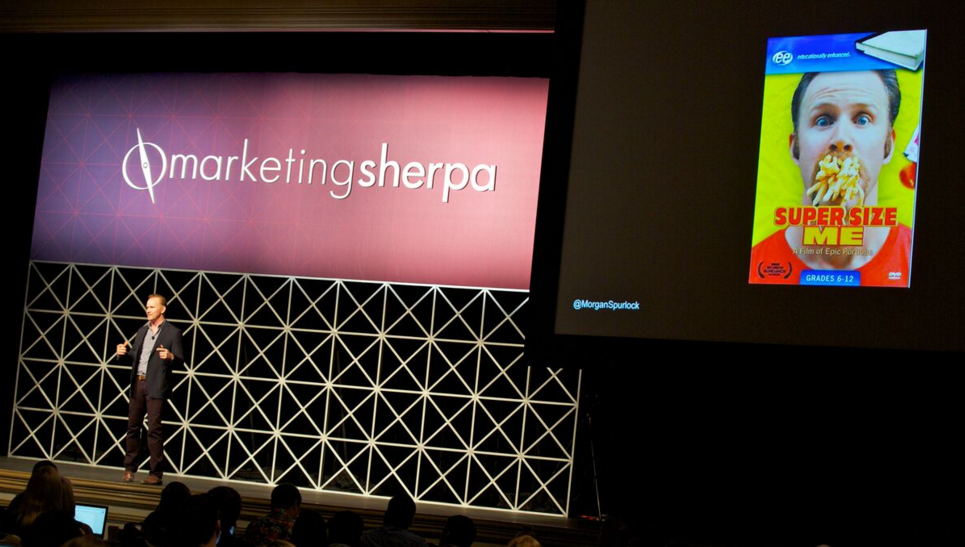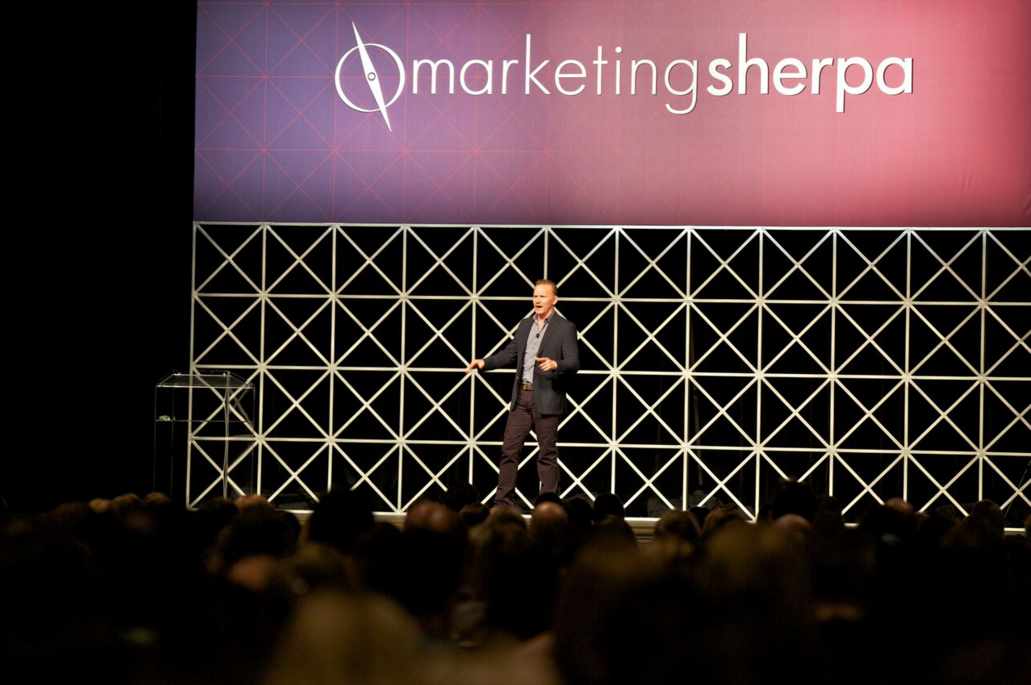Live From MarketingSherpa Summit 2016: Morgan Spurlock and using storytelling in your campaigns
This week the MarketingSherpa team is live in Las Vegas at Summit 2016. We are so excited to see all of the attendees who came out to learn with us at the beautiful Bellagio, and with thirty speakers diving into case studies on topics such as Digital & Data, Content & Social and Email & Mobile, there is so much to learn from our marketing peers.
This morning, Morgan Spurlock, Academy Award-nominated director and one of our featured speakers at MarketingSherpa Summit 2016, presented “The Greatest Lecture Ever Told.”
Read on for some of the many insights Spurlock shared with the audience.
Marketing is storytelling
Morgan opened with the idea that, with storytelling, you don’t want to be like everyone else — you want to bring something unique to the table — and you want to do the right thing, from a moral standpoint. And yet, you don’t want to go too far and be too crazy. “What does it take to create original stories that can make a difference?” Morgan asked the audience.
As marketers, the content we produce for our consumers is the story they get about our brand. For Morgan, he always knew that he wanted to be a filmmaker and tell stories but it was the film Super Size Me that gave him “a compass as a storyteller.”
Relating this to marketing, Morgan made the bridge that it is important to know what your brand voice is — what you stand for and what you want consumers to recognize with your company.
For instance, Morgan showed a clip from a film produced by Ross Kauffman called Fire with Fire. This content was designed to play on the audience’s emotions — it featured a young girl battling fatal cancer. It was produced by GE, but the only time the audience saw a GE product was at both the beginning and the end of the film. Unlike a video going in depth about how a GE product works, the brand instead showcased an incredible story about a child overcoming a horrendous illness.
An important part of Morgan’s speech was brand ideology. Häagen-Dazs created a 25-minute film with Morgan called Crafted. The film was about artisan food, knife and pottery makers, and the passion these people have for their art. Crafted was streamed on Amazon, with its own URL. This was the first time Amazon featured content in this way. Like we saw with GE and Fire with Fire — Häagen-Dazs wasn’t promoting its new seasonal flavors by throwing product in consumers’ faces and begging them to buy. Instead, consumers were inundated with the ideology — the essence — of the brand.
Marketers need to tell stories to sell their products. Because of the extreme amount of content available to consumers now, everyone is a storyteller, according to Morgan — from studios like Universal and Paramont to Amazon and Netflix to a brand.
“All people want is great stories … [and] they want it delivered in a way where they are not being sold anything,” Morgan said. He called this, instead of an ROI, an “ROE” — return on education.
Distribute content
Because there is so much content available, it is no longer enough that marketers create the right content, but now they also need to be able to distribute that content in the right way.
When Super Size Me was first shown in a middle school classroom, Morgan said that this sparked a protest. Students were surprised by what they saw in the film about the horrible nutrition of school lunches and thus staged a boycott. Within two weeks, Morgan said, these “young activists” had changed the school lunches being served.
Similarly, Morgan did an episode of 30 Days, his reality television show on the FX network, where he lived on minimum wage for one month and attempted to see a doctor about his wrist injury. Between his lack of health insurance and inability to miss work for an appointment at the free clinic, Morgan was unable to get the medical help that he needed. This episode was extremely popular and was distributed among state legislatures, leading to a discussion surrounding minimum wage, Morgan said.
In both of these instances, Morgan wasn’t necessarily trying to sell something; he was selling an ideology (healthy school lunches and better minimum wage). And yet, because the content resonated with the audiences who saw it, it lead to actual change.
“You can plan for impact and how you hope to affect change,” Morgan said.
Take (reasonable) risks
Morgan said this is the best time to take risks because “there are so many ways to distribute content and so many ways to do it.”
When Morgan made The Greatest Movie Ever Sold — a movie about product placement paid for by product placement — the goal of the film was transparency. They wanted consumers to be able to see the marketing that went into the film from beginning to end. He described it as “the Ironman of documentaries — everything from top to bottom was branded from beginning to end.”
In trying to make this film a reality, Morgan was told “no” by many brands, part of which he contributed to Super Size Me‘s effect on a legacy brand, McDonald’s.
“Surround yourself with people who believe in you and your mission,” Morgan said.
Another example he used was a commercial produced by Time Warner Cable that poked fun at what customers hate most about the brand — namely, waiting on hold for a long time.
It is important to try new things and take risks. Morgan pointed out that the more risks you take, the less risky they feel; it just becomes a part of what you do.
He closed by saying, “Getting into the hands, hearts and minds of your audience is the greatest accomplishment.”
Join us on March 9 for the post-Summit wrap-up webinar where we dive into all the things we learned at Summit.
You might also like
Live From MarketingSherpa Summit 2016: 5 steps to telling your team’s story internally
Live From MarketingSherpa Summit 2016: Humana on the power of iterative testing [From the MarketingExperiments blog]
3 Steps to Conquering CASL: An interview from Email Summit 2015
Brand Marketing: 5 tactics to understanding customer experience
Buying Versus Building Technology: Which is right for you?
Categories: Marketing












